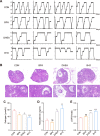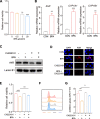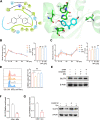Bisphenol a downregulates GLUT4 expression by activating aryl hydrocarbon receptor to exacerbate polycystic ovary syndrome
- PMID: 38200540
- PMCID: PMC10782693
- DOI: 10.1186/s12964-023-01410-y
Bisphenol a downregulates GLUT4 expression by activating aryl hydrocarbon receptor to exacerbate polycystic ovary syndrome
Abstract
Background: Bisphenol A (BPA) levels are high in women with polycystic ovary syndrome (PCOS). The mechanism by which BPA induces abnormal glucose metabolism in PCOS patients is largely unknown.
Methods: Serum and urine samples were collected from women with and without PCOS (control) at the reproductive medicine center with informed consent. Non-PCOS patients who received in vitro fertilization were recruited for collection of ovarian follicular fluid and granular cells. Wild-type C57BL/6 and AhR -/- mice were used to verify the effects of BPA on PCOS. Real-time PCR, western blotting, and ELISA were conducted to analyze the function of BPA. Chip-qPCR verified the role of AhR in GLUT4 transcription. Flow cytometry was performed to determine glucose uptake.
Results: A positive correlation was observed between BPA concentration and serum BPA levels in PCOS patients. BPA aggravated the changes in PCOS with abnormal glucose metabolism, impaired fertility, and increased body fat. Mechanistically, we showed that BPA activated AhR and led to decreased glucose transport via GLUT4 downregulation in ovarian granular cells. Therefore, the use of inhibitors or knockout of AhR could effectively rescue BPA-induced metabolic disorders in PCOS mice.
Conclusions: Our results revealed that BPA suppressed GLUT4 expression and induced abnormal glucose metabolism by activating AhR, causing insulin resistance, and is thus a potential contributor to the development of PCOS. Therefore, AhR could be a potential new therapeutic target for PCOS. Video Abstract.
Keywords: Aryl hydrocarbon receptor; Bisphenol a; Glucose transporter 4; Ovarian granulosa cells; Polycystic ovary syndrome.
© 2024. The Author(s).
Conflict of interest statement
The authors declare no competing interests.
Figures







References
-
- Kakoly NS, Khomami MB, Joham AE, Cooray SD, Misso ML, Norman RJ, Harrison CL, Ranasinha S, Teede HJ, Moran LJ. Ethnicity, obesity and the prevalence of impaired glucose tolerance and type 2 diabetes in PCOS: a systematic review and meta-regression. Hum Reprod Update. 2018;24:455–467. doi: 10.1093/humupd/dmy007. - DOI - PubMed
Publication types
MeSH terms
Substances
LinkOut - more resources
Full Text Sources
Medical

